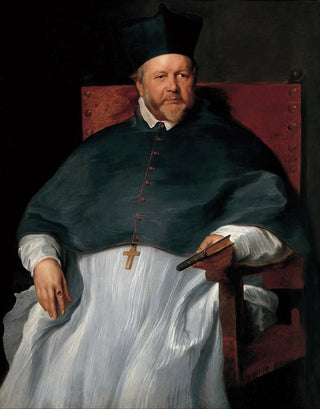Art print | Bishop Jan Van Malderen - Antoine van Dyck


View from behind

Frame (optional)
In the fascinating world of baroque painting, the art print "Bishop Jan Van Malderen" by Antoine van Dyck stands out for its intensity and depth. This masterful depiction of a clergyman, imbued with serenity and dignity, transports us to a time when art reflected the spiritual and social values of its era. The art print Bishop Jan Van Malderen - Antoine van Dyck offers a unique opportunity to rediscover the artist's genius and to grasp the nuances of his style.
Style and uniqueness of the work
The composition of this piece is characterized by a subtle play of light and shadow, typical of van Dyck's style. The artist uses light to emphasize the features of the bishop's face, revealing an expression that is both benevolent and authoritative. The sumptuous drapery of the ecclesiastical robe, with its delicate reflections, demonstrates van Dyck's technical mastery in depicting textures. Every brushstroke seems loaded with meaning, every color carefully chosen to evoke a solemn atmosphere. The background, often dark, highlights the central figure, creating a contrast that immediately draws the viewer's eye. This tableau does not merely depict a character; it tells a story, that of a man entrusted with a spiritual and social mission, inviting reflection on the role of the Church at that time.
The artist and his influence
Antoine van Dyck, a pupil of Rubens, established himself as one of the greatest portraitists of his era. His style, marked by refinement and delicacy, influenced many artists across Europe. By choosing to paint portraits of prominent personalities, he not only celebrated their status but also contributed to the construction of a baroque visual identity. Van Dyck was able to capture the essence of his subjects, endowing them with an almost living dimension. His innovative approach paved the way for a new way of conceptualizing portraiture, where the individuality and character of the subject took precedence over strict conventions of representation.

Matte finish

View from behind

Frame (optional)
In the fascinating world of baroque painting, the art print "Bishop Jan Van Malderen" by Antoine van Dyck stands out for its intensity and depth. This masterful depiction of a clergyman, imbued with serenity and dignity, transports us to a time when art reflected the spiritual and social values of its era. The art print Bishop Jan Van Malderen - Antoine van Dyck offers a unique opportunity to rediscover the artist's genius and to grasp the nuances of his style.
Style and uniqueness of the work
The composition of this piece is characterized by a subtle play of light and shadow, typical of van Dyck's style. The artist uses light to emphasize the features of the bishop's face, revealing an expression that is both benevolent and authoritative. The sumptuous drapery of the ecclesiastical robe, with its delicate reflections, demonstrates van Dyck's technical mastery in depicting textures. Every brushstroke seems loaded with meaning, every color carefully chosen to evoke a solemn atmosphere. The background, often dark, highlights the central figure, creating a contrast that immediately draws the viewer's eye. This tableau does not merely depict a character; it tells a story, that of a man entrusted with a spiritual and social mission, inviting reflection on the role of the Church at that time.
The artist and his influence
Antoine van Dyck, a pupil of Rubens, established himself as one of the greatest portraitists of his era. His style, marked by refinement and delicacy, influenced many artists across Europe. By choosing to paint portraits of prominent personalities, he not only celebrated their status but also contributed to the construction of a baroque visual identity. Van Dyck was able to capture the essence of his subjects, endowing them with an almost living dimension. His innovative approach paved the way for a new way of conceptualizing portraiture, where the individuality and character of the subject took precedence over strict conventions of representation.






